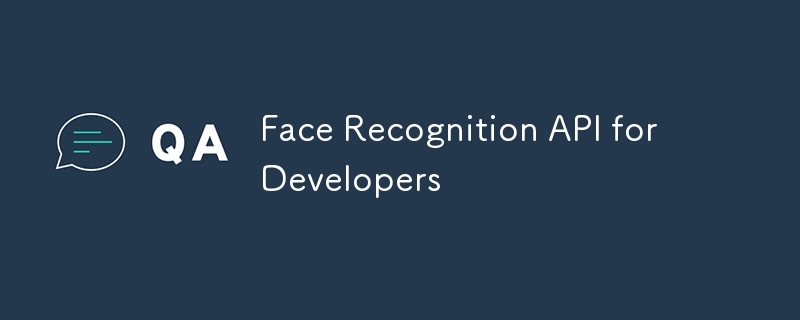

Selecting the right face recognition API is a critical step for developers aiming to incorporate facial recognition features into their applications. With numerous options available, making an informed decision requires careful consideration of various factors, from technical capabilities to cost and licensing.
When choosing a face recognition API, developers should begin by identifying their specific needs. Key criteria to evaluate include accuracy, speed, and the range of features offered by the API. For instance, some APIs excel in detecting and recognizing faces in diverse lighting conditions, while others might offer specialized capabilities like emotion detection or age estimation. It’s also important to assess the ease of integration, especially if you’re working within an existing tech stack. Additionally, factors such as scalability, security, and compliance with data privacy regulations (like GDPR) play crucial roles in determining the right fit for your project.
To make an informed choice, comparing popular face recognition APIs can be incredibly useful. Major providers like Amazon Rekognition, Microsoft Azure Face API, and Google Cloud Vision each offer unique strengths.
Learn more here: Top Face Recognition APIs in 2024
Pricing and licensing are also pivotal factors when choosing a face recognition API. Pricing models typically vary based on the number of API calls, the complexity of the tasks performed, or the level of service (such as free tier, pay-as-you-go, or subscription-based models). For example, Luxand.cloud offers a subscription-based model.
Developers need to consider the projected usage of the API to avoid unexpected costs. Additionally, licensing terms should be carefully reviewed to ensure compliance with the intended use of the API. For example, some APIs might have restrictions on usage in certain industries or geographical regions, or they might require additional fees for commercial use. Balancing these financial and legal considerations with the technical capabilities of the API will help ensure that the chosen solution is both effective and sustainable for your application.
Face recognition APIs offer a range of functionalities that can significantly enhance applications by incorporating advanced facial recognition technology. Understanding these common functions—face detection and landmark identification, face verification and matching, emotion and age detection, and handling multiple faces in a single image—can help developers leverage these tools effectively.
At the heart of face recognition technology is face detection, a fundamental function that identifies the presence of faces within an image. This process involves scanning an image to locate and outline the regions where faces are present. Once a face is detected, landmark identification comes into play. This function maps key facial features such as the eyes, nose, and mouth, creating a detailed outline of the face. These landmarks are crucial for subsequent recognition tasks, as they provide a reference framework for analyzing and comparing facial features with high precision.
Face verification and matching are critical functions for applications that require confirming identities or linking faces across different images. Face verification involves comparing a detected face with a reference face to determine if they belong to the same individual. This is commonly used in security systems for authentication purposes. Face matching, on the other hand, compares multiple faces against a database to find potential matches. This function is essential for applications such as social media tagging, where the goal is to identify or suggest friends in uploaded photos.
Advanced face recognition APIs go beyond simple identification to offer insights into a person’s emotional state and age. Emotion detection analyzes facial expressions to identify feelings such as happiness, sadness, anger, or surprise. This can be particularly useful for enhancing user experiences in interactive applications, such as virtual assistants or customer feedback systems. Age detection estimates the age of an individual based on their facial features, providing demographic insights that can be used in targeted marketing or personalized content delivery.
現実世界の多くのシナリオには複数の顔が含まれる画像が含まれており、堅牢な顔認識 API はこれを効率的に処理する必要があります。この機能は、1 枚の画像内で顔をそれぞれ検出して処理し、個人ごとに個別のデータを提供します。この機能は、画像に人々のグループが含まれることが多い、イベント写真撮影、セキュリティ監視、ソーシャル メディア プラットフォームなどのアプリケーションにとって非常に重要です。複数の顔を正確に管理することで、API は各顔を個別に認識して分析することを保証し、正確なデータ収集と分析を可能にします。
Luxand.cloud 顔認識 API Luxand.cloud 顔認識 API は、顔認識テクノロジーをアプリケーションに統合するための最先端のソリューションを提供します。この API は、堅牢かつスケーラブルな顔認識機能を提供するように設計されており、セキュリティや認証から、パーソナライズされたユーザー エクスペリエンスやデータ分析まで、幅広いユースケースに対応します。 Luxand.cloud 顔認識 API の概要 Luxand.cloud の顔認識 API は、開発者が高度な顔認識機能をアプリケーションに簡単に組み込むことができるクラウドベースのサービスです。 API は、洗練されたアルゴリズムと機械学習モデルを活用して、正確かつ効率的な顔の検出と認識を実現します。柔軟でアクセスしやすいように設計されているため、開発者は複雑な顔認識システムを一から開発する必要がなく、革新的なソリューションの作成に集中できます。詳細はこちら: 開発者向け顔認識 API
The above is the detailed content of Face Recognition API for Developers. For more information, please follow other related articles on the PHP Chinese website!




